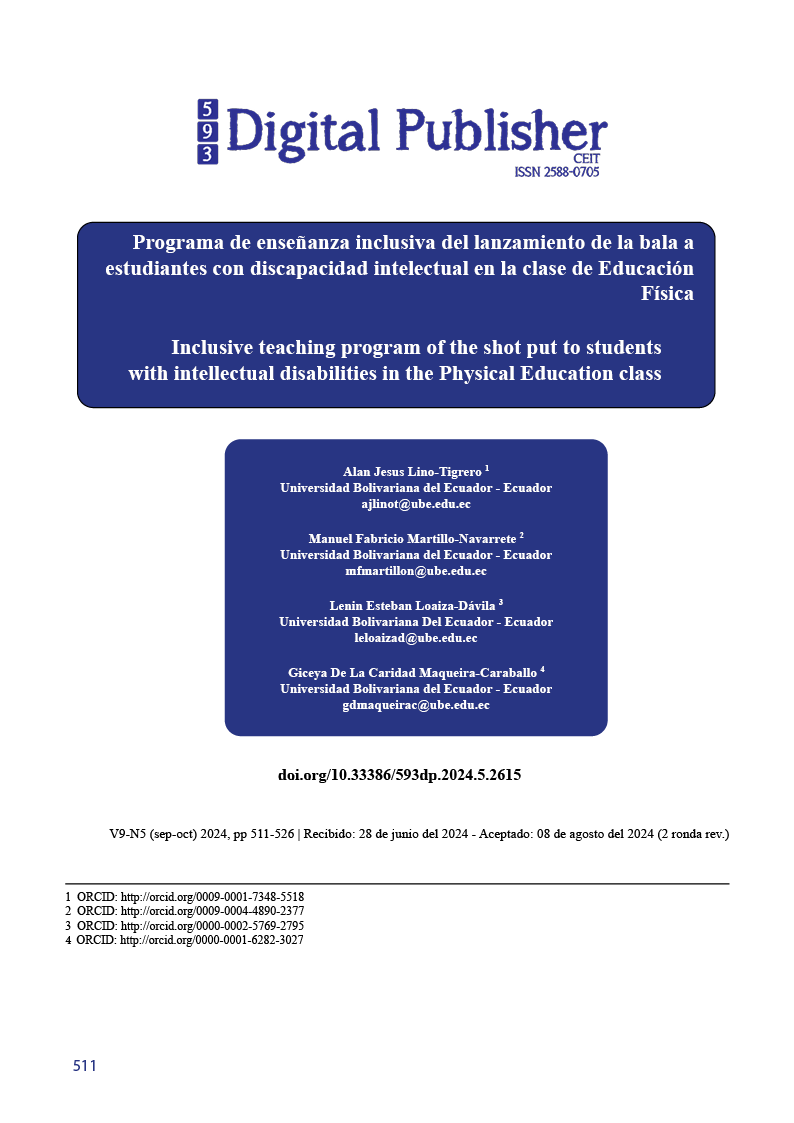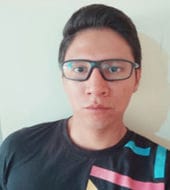Inclusive teaching program of the shot put to students with intellectual disabilities in the Physical Education class
Main Article Content
Abstract
Study developed with the objective of designing an inclusive teaching program of the shot put for students with intellectual disabilities in Physical Education classes, using a mixed approach that combined quantitative and qualitative methods for its validation. The sample included 14 first-year Unified General Baccalaureate students aged 16-17 years, 2 of whom presented a diagnosis of intellectual disability (mild and moderate) and 12 were considered conventional The program, with a duration of eight weeks and two 40-minute sessions per week, was designed to improve the inclusion and participation of all students. Quantitative results showed significant improvements in technical skills such as throwing technique, strength, power and body coordination, statistically proven through the Wilcoxon test presenting significant differences in all parameters evaluated at a level of P≤0.05. Complementarily, the qualitative approach through a case study, highlighted an increase in students' confidence and autonomy, evidencing a better ability to follow instructions and request feedback. In addition, students showed greater willingness to participate in group activities and explore new skills, suggesting improved social integration and emotional development within an inclusive educational environment. This study underscores how well-tailored interventions can significantly foster both technical and socioemotional development in students with intellectual disabilities, as gains reflect the success of adaptations in equipment and teaching methodologies, allowing students to not only participate more effectively but also improve markedly in athletic performance.
Downloads
Article Details

This work is licensed under a Creative Commons Attribution-NonCommercial-ShareAlike 4.0 International License.
1. Derechos de autor
Las obras que se publican en 593 Digital Publisher CEIT están sujetas a los siguientes términos:
1.1. 593 Digital Publisher CEIT, conserva los derechos patrimoniales (copyright) de las obras publicadas, favorece y permite la reutilización de las mismas bajo la licencia Licencia Creative Commons 4.0 de Reconocimiento-NoComercial-CompartirIgual 4.0, por lo cual se pueden copiar, usar, difundir, transmitir y exponer públicamente, siempre que:
1.1.a. Se cite la autoría y fuente original de su publicación (revista, editorial, URL).
1.1.b. No se usen para fines comerciales u onerosos.
1.1.c. Se mencione la existencia y especificaciones de esta licencia de uso.
References
Abellán Hernández, J. (2013). Evaluación de las pruebas motrices relacionadas con el lanzamiento en deportistas con discapacidad intelectual (Evaluation of the motor shooting tests in athletes with intellectual disabilities). Retos, 24, 63–66. https://doi.org/10.47197/retos.v0i24.34529
Abellán, J., y Segovia, Y. (2021). Educación deportiva y alumnado con discapacidad intelectual: un estudio de cuatro casos. RICYDE. Revista Internacional de Ciencias del Deporte. 63(17), 38-55. https://doi.org/10.5232/ricyde2021.06304
Al-Aqra, H.,yAl-Mallahi, S. (2022). Diseño de una propuesta de programa de entrenamiento que combine el entrenamiento con pesas y flexibilidad y su efecto sobre las cualidades físicas y el nivel digital de las jugadoras de lanzamiento de peso con discapacidad F56. Revista de Ciencias Naturales de la Universidad de Hunan. https://doi.org/10.55463/issn.1674-2974.49.9.19.
Bota, A., Teodorescu, S.,yŞerbănoiu, S. (2014). Deporte unificado: un factor de inclusión social en las comunidades escolares para jóvenes con discapacidad intelectual. Procedia - Ciencias Sociales y del Comportamiento, 117, 21-26. https://doi.org/10.1016/J.SBSPRO.2014.02.172.
Cañadas, L.,yCalle-Molina, M. T. (2020). Efectos de un programa de Educación Física en el aprendizaje de alumnado universitario con discapacidad intelectual. Siglo Cero, 51(4), 53–68. https://doi.org/10.14201/scero20205145368
Chauca Guaman, M. D.,yRosero Morales, E. del R. (2021). Prácticas inclusivas en la Educación Física en estudiantes de básica media. Uniandes Episteme, 8(3), 433–447. Recuperado a partir de https://revista.uniandes.edu.ec/ojs/index.php/EPISTEME/article/view/2198
Erofeeva, M. A., Ulyanova, I. V., Plakhotnikova, I. V., Kurilyuk, Y. E., Egorov, V. A.,yKochetkov, I. G. (2019). Reforming and developing socialization of children with limited abilities (mild intellectual disability). Electronic Journal of General Medicine, 16(2), em112. https://doi.org/10.29333/ejgm/108598
Fernández-Batanero, J., Montenegro-Rueda, M.,yFernández-Cerero, J. (2022). Access and Participation of Students with Disabilities: The Challenge for Higher Education. International Journal of Environmental Research and Public Health, 19(19):11918. https://doi.org/10.3390/ijerph191911918
Fonseca Calderón, P. F.,yGonzález León, L. (2020). La educación inclusiva desde el ejercicio físico en la Universidad de Cienfuegos. Revista Conrado, 15(71), 216-221. https://conrado.ucf.edu.cu/index.php/conrado/article/view/1223
Giménez-Egido, J., Ortega-Toro, E., Palao, J., Verdu-Conesa, I., & Torres-Luque, G. (2020). Effect of Modification Rules in Competition on Technical–Tactical Action in Young Tennis Players (Under-10). Frontiers in Psychology, 10. https://doi.org/10.3389/fpsyg.2019.02789.
Hamby, C., Lunkenheimer, E.,yFisher, P. (2019). El potencial de las intervenciones de retroalimentación de video para mejorar las habilidades de interacción entre padres e hijos en padres con discapacidad intelectual. Revisión de Servicios para Niños y Jóvenes. https://doi.org/10.1016/J.CHILDYOUTH.2019.104395.
Hernández Álvarez, A., Fernández Cabrera, J. M., Álvarez Pérez, P.,yLópez Aguilar, D. (2022). REVISIÓN DE ESTUDIOS SOBRE INCLUSIÓN EN EDUCACIÓN FÍSICA: PERÍODO 2014-2018. Acción Motriz, 23(1), 22–29. Recuperado a partir de https://www.accionmotriz.com/index.php/accionmotriz/article/view/133
Hudson, M. E., Browder, D. M., & Wood, L. A. (2013). Review of Experimental Research on Academic Learning by Students with Moderate and Severe Intellectual Disability in General Education. Research and Practice for Persons with Severe Disabilities, 38(1), 17-29. https://doi.org/10.2511/027494813807046926
Hutchins, N. S., Burke, M. D., Bowman-Perrott, L., Tarlow, K. R., & Hatton, H. (2020). The Effects of Social Skills Interventions for Students With EBD and ASD: A Single-Case Meta-Analysis. Behavior Modification, 44(5), 773-794. https://doi.org/10.1177/0145445519846817
Kuntz, E., & Carter, E. (2019). Review of Interventions Supporting Secondary Students with Intellectual Disability in General Education Classes. Research and Practice for Persons with Severe Disabilities, 44, 103 - 121. https://doi.org/10.1177/1540796919847483.
Lavega, P., Planas, A.,yRuiz, P. (2014). Juegos cooperativos e inclusión en Educación Física. Revista Internacional de Medicina y Ciencias de la Actividad Física y del Deporte / International Journal of Medicine and Science of Physical Activity and Sport, 14(53), 37-51. https://www.redalyc.org/articulo.oa?id=54230508003
Marín-Suelves, D.,yRamón-Llin, J. (2021). Physical Education and Inclusion: a Bibliometric Study. Apunts. Educación Física y Deportes, 143, 17-26. https://doi.org/10.5672/apunts.2014-0983.es.(2021/1).143.03
Molina, J. P.,yBeltrán, V. (2007). Incompetencia motriz e ideología del rendimiento en Educación Física: El caso de un alumno con discapacidad intelectual. Motricidad. European Journal of Human Movement, 19(4), 165-190. https://www.redalyc.org/articulo.oa?id=274220371009
Palma-Quimis, J. F., Macías-Hernández, A. R., Romero-Ibarra, O. P.,yMaqueira-Caraballo, G. de la C. (2024). Actividades de expresión corporal para la inclusión de estudiantes con discapacidad intelectual en la clase de Educación Física . MQRInvestigar, 8(1), 3549–3565. https://doi.org/10.56048/MQR20225.8.1.2024.3549-3565
Pitetti, K., Miller, R.,yLoovis, M. (2017). Balance and Coordination Capacities of Male Children and Adolescents With Intellectual Disability. Adapted physical activity quarterly: APAQ, 34 1, 1-18 . https://doi.org/10.1123/APAQ.2016-0010.
Proenza-Pupo, J. R. (2020). Educación Física inclusiva: modelo y paradigma. Revista científica Especializada En Ciencias De La Cultura Física Y Del Deporte, 18(47), 145–160. https://deporvida.uho.edu.cu/index.php/deporvida/article/view/662
Ríos, G. C. B. (2024). Rúbrica de evaluación para el lanzamiento de la bala en la asignatura de Deporte - Atletismo. https://edtk.co/rbk/111544
Solís García, P.,yBorja González, V. (2021). Actitudes del profesorado de Educación Física hacia la inclusión de alumnos con discapacidad (Physical Education teachers’ attitudes towards the inclusion of students with disabilities). Retos, 39, 7–12. https://doi.org/10.47197/retos.v0i39.77841
Tashakkori, A., & Teddlie, C. (2003). Handbook on mixed methods in the behavioral and social sciences. 1, 13-50.
Top, E.,yAkil, M. (2023). Effect of theraband exercises on muscle strength and motor development of individuals with moderate intellectual disability. Somatosensoryymotor research, 1-8 . https://doi.org/10.1080/08990220.2023.2194386.
Wilkinson, K., Zimmerman, T.,yLight, J. (2021). Atención visual a los objetivos indicados en pantallas de comunicación aumentada y alternativa asistida simulada para personas con discapacidades intelectuales y del desarrollo. Revista de investigación del habla, el lenguaje y la audición: JSLHR, 1-13 . https://doi.org/10.1044/2021_JSLHR-20-00451.





